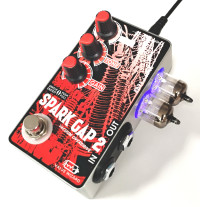Unusual Valve Overdrive Effect

A simple and unusual low-voltage valve overdrive effect for guitar.
Most guitar overdrive effects rely on diode clipping to generate distortion, and many players like to experiment with different kinds of diode, Zeners, and LEDs. Some also experiment with valve diodes in an attempt to emulate the sound of an overdriven valve amplifier. However, at low voltages the results are often disappointing, because a valve diode will normally conduct some forward current even when the voltage across it is zero or slightly negative (this current is driven by the space charge itself). For very small signals, a valve diode therefore looks more like a resistor than a diode, producing a weak distortion sound at best.
However, some years ago I discovered something interesting about the EB91/6AL5 –a very inexpensive double diode. When its heater voltage is reduced, its whole I/V characteristic shifts to the right, creating a useful diode characteristic for small signals, as illustrated in the image. I used this property to create a very satisfying ‘true’ valve overdrive effect (most other valves do not behave this way, their dynamic resistance simply increases when the heater voltage is reduced, without changing the actual diode threshold voltage).
Since effects pedals normally operate from a 9V supply, two valves were used with their heaters in series, so each operates at 4.5V. The junction of the two heaters also provides a convenient half-rail voltage –filtered by R13 and C13– for biasing the opamps. R12 and C14 provide additional filtering for the opamp’s supply rail, and D1 provides polarity protection.
U1a buffers the incoming guitar signal as well as providing adjustable gain. C2 and C3 progressively narrow the bandwidth as the gain is increased, to reduce ‘muddiness’ at the low end and shrillness at the high end. U1b serves as a second buffer and final tone control, tuned to produce a very realistic imitation of the sound of a guitar amplifier.
Since the dynamic resistance of the valves is relatively high, two stages of diode clipping are cascaded between the two opamps, so a high level of distortion can be achieved. C5 and C6 provide additional filtering of excessively shrill harmonics. With SW1 closed, both clipping stages are symmetrical, which mimics the symmetrical clipping of a purely push-pull amplifier, and the final result is similar to most diode-clipping pedals on the market. But there is one final trick to be played here.
When SW1 is open, the first clipping stage becomes asymmetrical. C4 is now able to charge rapidly through R6+V1 on positive cycles, but it can only discharge more slowly through R6+R7+V2 on negative cycles. This causes the average voltage across V1 to shift negatively during overdrive, which dynamically changes the clipping threshold depending on the signal amplitude. Exactly the same effect occurs in most real valve amplifiers. It causes the overdrive sound to change or ‘swirl’ as the guitar signal sustains and decays, and it allows the player to exploit different tones by varying how hard s/he plays, ‘riding’ the clipping threshold as it were. This is something most commercial distortion pedals do not do, leading them to sound rather monotonous compared to a real amplifier.
Finally, MOSFET Q1 provides click-free switching of the status LEDs, allowing a DPDT footswitch to be used for bypassing the effect. I mounted the LEDs underneath the valves so they light up when the effect is active. Total current consumption is about 260mA, depending on valve heater tolerance. This is relatively high for a pedal, so battery power is out of the question. It is essential to use a good quality, quiet power supply, which is often the price that is paid for using valves, but well worth it in my opinion.



Discussion (0 commentaire(s))